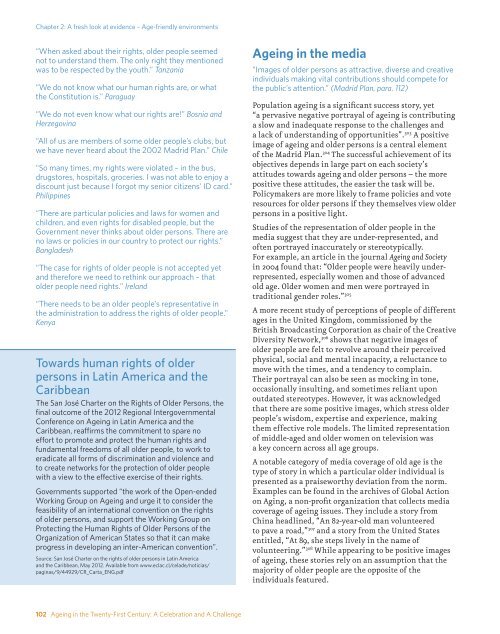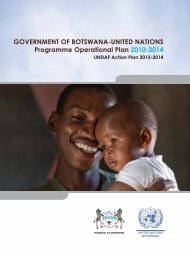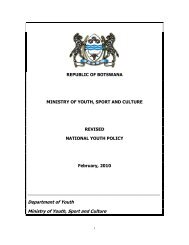Ageing in the Twenty-First Century: - HelpAge International
Ageing in the Twenty-First Century: - HelpAge International
Ageing in the Twenty-First Century: - HelpAge International
You also want an ePaper? Increase the reach of your titles
YUMPU automatically turns print PDFs into web optimized ePapers that Google loves.
Chapter 2: A fresh look at evidence – Age-friendly environments<br />
“When asked about <strong>the</strong>ir rights, older people seemed<br />
not to understand <strong>the</strong>m. The only right <strong>the</strong>y mentioned<br />
was to be respected by <strong>the</strong> youth.” Tanzania<br />
“We do not know what our human rights are, or what<br />
<strong>the</strong> Constitution is.” Paraguay<br />
“We do not even know what our rights are!” Bosnia and<br />
Herzegov<strong>in</strong>a<br />
“All of us are members of some older people’s clubs, but<br />
we have never heard about <strong>the</strong> 2002 Madrid Plan.” Chile<br />
“So many times, my rights were violated – <strong>in</strong> <strong>the</strong> bus,<br />
drugstores, hospitals, groceries. I was not able to enjoy a<br />
discount just because I forgot my senior citizens’ ID card.”<br />
Philipp<strong>in</strong>es<br />
“There are particular policies and laws for women and<br />
children, and even rights for disabled people, but <strong>the</strong><br />
Government never th<strong>in</strong>ks about older persons. There are<br />
no laws or policies <strong>in</strong> our country to protect our rights.”<br />
Bangladesh<br />
“The case for rights of older people is not accepted yet<br />
and <strong>the</strong>refore we need to reth<strong>in</strong>k our approach – that<br />
older people need rights.” Ireland<br />
“There needs to be an older people’s representative <strong>in</strong><br />
<strong>the</strong> adm<strong>in</strong>istration to address <strong>the</strong> rights of older people.”<br />
Kenya<br />
Towards human rights of older<br />
persons <strong>in</strong> Lat<strong>in</strong> America and <strong>the</strong><br />
Caribbean<br />
The San José Charter on <strong>the</strong> Rights of Older Persons, <strong>the</strong><br />
f<strong>in</strong>al outcome of <strong>the</strong> 2012 Regional Intergovernmental<br />
Conference on <strong>Age<strong>in</strong>g</strong> <strong>in</strong> Lat<strong>in</strong> America and <strong>the</strong><br />
Caribbean, reaffirms <strong>the</strong> commitment to spare no<br />
effort to promote and protect <strong>the</strong> human rights and<br />
fundamental freedoms of all older people, to work to<br />
eradicate all forms of discrim<strong>in</strong>ation and violence and<br />
to create networks for <strong>the</strong> protection of older people<br />
with a view to <strong>the</strong> effective exercise of <strong>the</strong>ir rights.<br />
Governments supported “<strong>the</strong> work of <strong>the</strong> Open-ended<br />
Work<strong>in</strong>g Group on <strong>Age<strong>in</strong>g</strong> and urge it to consider <strong>the</strong><br />
feasibility of an <strong>in</strong>ternational convention on <strong>the</strong> rights<br />
of older persons, and support <strong>the</strong> Work<strong>in</strong>g Group on<br />
Protect<strong>in</strong>g <strong>the</strong> Human Rights of Older Persons of <strong>the</strong><br />
Organization of American States so that it can make<br />
progress <strong>in</strong> develop<strong>in</strong>g an <strong>in</strong>ter-American convention”.<br />
Source: San José Charter on <strong>the</strong> rights of older persons <strong>in</strong> Lat<strong>in</strong> America<br />
and <strong>the</strong> Caribbean, May 2012. Available from www.eclac.cl/celade/noticias/<br />
pag<strong>in</strong>as/9/44929/CR_Carta_ENG.pdf<br />
<strong>Age<strong>in</strong>g</strong> <strong>in</strong> <strong>the</strong> media<br />
“Images of older persons as attractive, diverse and creative<br />
<strong>in</strong>dividuals mak<strong>in</strong>g vital contributions should compete for<br />
<strong>the</strong> public’s attention.” (Madrid Plan, para. 112)<br />
Population age<strong>in</strong>g is a significant success story, yet<br />
“a pervasive negative portrayal of age<strong>in</strong>g is contribut<strong>in</strong>g<br />
a slow and <strong>in</strong>adequate response to <strong>the</strong> challenges and<br />
a lack of understand<strong>in</strong>g of opportunities”. 303 A positive<br />
image of age<strong>in</strong>g and older persons is a central element<br />
of <strong>the</strong> Madrid Plan. 304 The successful achievement of its<br />
objectives depends <strong>in</strong> large part on each society’s<br />
attitudes towards age<strong>in</strong>g and older persons – <strong>the</strong> more<br />
positive <strong>the</strong>se attitudes, <strong>the</strong> easier <strong>the</strong> task will be.<br />
Policymakers are more likely to frame policies and vote<br />
resources for older persons if <strong>the</strong>y <strong>the</strong>mselves view older<br />
persons <strong>in</strong> a positive light.<br />
Studies of <strong>the</strong> representation of older people <strong>in</strong> <strong>the</strong><br />
media suggest that <strong>the</strong>y are under-represented, and<br />
often portrayed <strong>in</strong>accurately or stereotypically.<br />
For example, an article <strong>in</strong> <strong>the</strong> journal <strong>Age<strong>in</strong>g</strong> and Society<br />
<strong>in</strong> 2004 found that: “Older people were heavily underrepresented,<br />
especially women and those of advanced<br />
old age. Older women and men were portrayed <strong>in</strong><br />
traditional gender roles.” 305<br />
A more recent study of perceptions of people of different<br />
ages <strong>in</strong> <strong>the</strong> United K<strong>in</strong>gdom, commissioned by <strong>the</strong><br />
British Broadcast<strong>in</strong>g Corporation as chair of <strong>the</strong> Creative<br />
Diversity Network, 306 shows that negative images of<br />
older people are felt to revolve around <strong>the</strong>ir perceived<br />
physical, social and mental <strong>in</strong>capacity, a reluctance to<br />
move with <strong>the</strong> times, and a tendency to compla<strong>in</strong>.<br />
Their portrayal can also be seen as mock<strong>in</strong>g <strong>in</strong> tone,<br />
occasionally <strong>in</strong>sult<strong>in</strong>g, and sometimes reliant upon<br />
outdated stereotypes. However, it was acknowledged<br />
that <strong>the</strong>re are some positive images, which stress older<br />
people’s wisdom, expertise and experience, mak<strong>in</strong>g<br />
<strong>the</strong>m effective role models. The limited representation<br />
of middle-aged and older women on television was<br />
a key concern across all age groups.<br />
A notable category of media coverage of old age is <strong>the</strong><br />
type of story <strong>in</strong> which a particular older <strong>in</strong>dividual is<br />
presented as a praiseworthy deviation from <strong>the</strong> norm.<br />
Examples can be found <strong>in</strong> <strong>the</strong> archives of Global Action<br />
on Ag<strong>in</strong>g, a non-profit organization that collects media<br />
coverage of age<strong>in</strong>g issues. They <strong>in</strong>clude a story from<br />
Ch<strong>in</strong>a headl<strong>in</strong>ed, “An 82-year-old man volunteered<br />
to pave a road,” 307 and a story from <strong>the</strong> United States<br />
entitled, “At 89, she steps lively <strong>in</strong> <strong>the</strong> name of<br />
volunteer<strong>in</strong>g.” 308 While appear<strong>in</strong>g to be positive images<br />
of age<strong>in</strong>g, <strong>the</strong>se stories rely on an assumption that <strong>the</strong><br />
majority of older people are <strong>the</strong> opposite of <strong>the</strong><br />
<strong>in</strong>dividuals featured.<br />
102 <strong>Age<strong>in</strong>g</strong> <strong>in</strong> <strong>the</strong> <strong>Twenty</strong>-<strong>First</strong> <strong>Century</strong>: A Celebration and A Challenge







